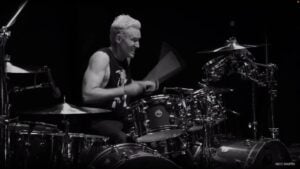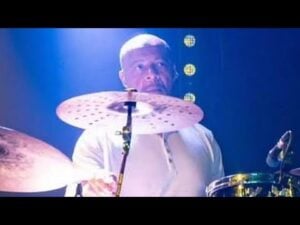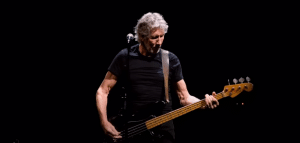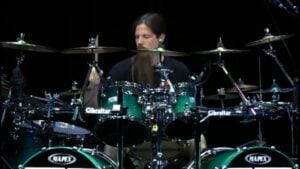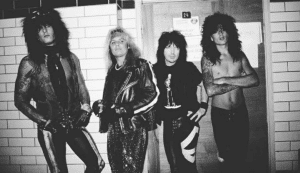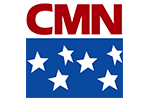Top 10 Guitar Riffs Of All-Time
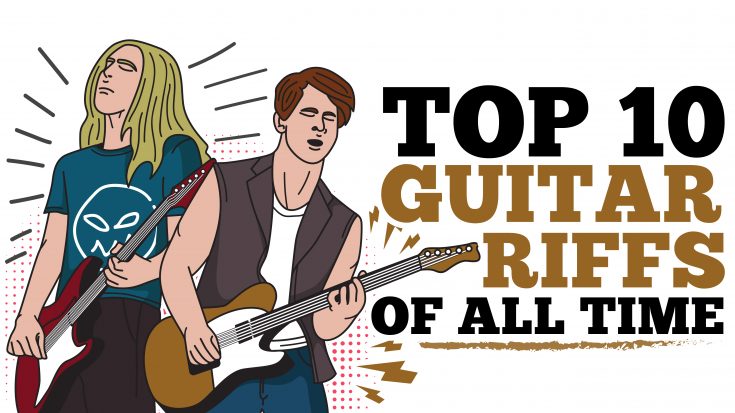
10. “Johnny B. Goode” by Chuck Berry

The Original Rock N’ Roller
Okay, definitely a change-up to kick of this list. But, we have to recognize what Chuck Berry did to pave the way for rock n’ roll to take off, and “Johnny B. Goode” is a wonderful example of the influence Berry had on future artists.
The opening riff of this song is instantaneously recognizable. In fact, we might as well go ahead and give joint credit to Louis Jordan for this iconic opening riff. A little known fact is that Berry mirrored the opening of Jordan’s “Ain’t That Just Like A Women” almost note for note. Berry’s take on the riff is a little more heavier, while Jordan’s is more on the softer, R&B style.
The lyrics follow a character named Johnny, a poor country boy who holds dreams and aspirations of playing in a rock band. Berry has admitted to the fact that the song is partially autobiographical. Originally the lyrics said “colored boy” instead of “country boy,” however Berry changed it to ensure that the song would be able to be played on the radio.
9. “You Really Got Me” by The Kinks

Before Van Halen, There Were These Guys
During the British Invasion in the 1960s, The Kinks dropped this landmark tune which ended up leading to their breakout, and placing them toward the forefront of the era. “You Really Got Me” has a garage rock feel, and is one of the earliest releases of the hard rock genre. While lead vocalist Ray Davies desired for the song to be a more “laid back” jazz number, it was lead guitarist and brother Dave Davies who originally suggested the hard rock feel. The riff was originally designed to be played on a piano, but when Dave played the chords on guitar, the rest was history.
The main riff of the song is powerful, and hard-hitting due to the overdrive and distortion in Davies guitar. Both brothers have noted that the song is still extremely fun to play live, and fans still go crazy over it. In fact, many have stated that the live version overshadows the studio version.
“You Really Got Me” has been covered numerous times. The most notable cover being by Van Halen in 1978, who’s version of the song reached the Billboard Top 40, and was the song that Eddie Van Halen’s “Eruption” led into.
8. “Beat It” by Michael Jackson

The ‘Pop King’s’ Song Has A Rockin’ Riff
Another surprise here at #8 with Michael Jackson’s “Beat It.” While “Beat It” may lean a little more on the pop side rather than rock, you can’t deny the riff throughout the song is one of the greatest ever constructed for both genres. Commonly misconceived, the main riff of the song was NOT played by Eddie Van Halen. Although Eddie played the solo, the main guitar riff was actually played by Paul Jackson Jr. and Toto guitarist Steve Lukather. The two guitarists’ ability to blend the pop and rock styles make the song stand out and it quickly became one of Jackson’s most well known, and that still holds true today.
Van Halen’s solo may overshadow the main riff, however the funkiness of the riff allows the listener to be able to dance, or just rock out to the song. The riff is the driving force of “Beat It,” and Jackson’s vocals, along with the pop beat make the song enjoyable for a fan of any genre.
Similar to our previous song on this list (“You Really Got Me”) Beat it has been covered by many, and arranged by a wide variety of genres. Pop Punk band Fall Out Boy put out a pop-punk version of the song in 2008 which featured guitarist John Mayer, while Weird Al Yankovic turned the song into a parody, with the release of his song “Eat It” in 1984.
7. “Back In Black” by AC/DC

You Can’t Help But Headbang
The titled, and opening track of AC/DC’s 1980 album Back In Black will go down as one of the heaviest songs in classic rock history. Immediately following drummer Phil Rudd counting in the Australian rock band, the listener is hit with a crashing wave of powerful guitar chords courtesy of brothers Angus and Malcolm Young. “Back and Black’s” driving riff is a non stop freight train, and the only way to react to it is throw up a fist and head bang.
“Back In Black” is a tribute to former lead vocalist Bon Scott, who died five months prior to the release of the album. The band replaced him with Brian Johnson who continued Scott’s legacy and launched the band into a new era. The lyrics “Forget the hearse ’cause I never die” implies that Scott will forever live through AC/DC’s music.
Angus and Malcolm wanted the song to be a celebration on Scott, rather than a morbid tribute. They approached Johnson to ask if he would write a lyric, and he came up with “Nine lives. Cats eyes. Abusing everyone of them and running wild,” off the top of his head, and received positive feedback from both brothers.
6. “Master Of Puppets” by Metallica

Every List Needs A Dash Of Metal
Definitely one of the most complex songs on our list, and easily the heaviest. It’s hard not to list a Metallica when ranking the top riffs in rock history. Although you could consider “Enter Sandman” to have the most recognizable riff of any Metallica song, it’s “Master of Puppets” off the album of the same name that has the best.
In fact, “Master of Puppets” has multiple riffs within the 8:36 headbanger. What makes this track so great is the variety of tempo changes throughout. As a listener, you go from a punch in the face intro, to a high speed verse and chorus section, and somehow end up in a slow ballad-like section before you end with the high speed section once again.
The meaning of “Master of Puppets” is a reference to drug addiction. Lead singer James Hetfield mentions that the title of the song refers to how things are switched around in addiction. The drugs become the “master” and the user becomes the “puppet.”
5. “Layla” by Derrick and the Dominoes

The Original ‘Mr. Steal Yo’ Girl’
We had to include an Eric Clapton riff on this list. Although Derrick and the Dominoes were short-lived, the group left a lasting legacy with this track. “Layla” had a very melodic riff, which almost screams throughout the song, and accompanies Clapton yelling during the chorus. Like “You Really Got Me,” “Layla” was originally written as a ballad, but was later changed and given a rock feel. It was actually Derrick and the Dominoes guitarist (and former lead of the Allman Brother’s Band) Duane Allman who drew up the song’s signature riff.
“Layla” was written by Clapton for Pattie Boyd. Boyd was married to Beatle’s guitarist George Harrison, a good friend of Clapton. Clapton was in love with Boyd, and actually married her in 1979, following her and Harrison divorcing in 1977. Clapton and Boyd would later divorce in 1988.
Following the split of Derrick and the Dominoes, Clapton released a solo unplugged version of “Layla” in 1992, which would go on to win a Grammy Award for “Best Rock Song.”
4. “Crazy Train” by Ozzy Osborne

The Anthem For Every Sporting Event Ever
Randy Rhode’s opening riff on “Crazy Train” is probably one of the first things a beginning guitar player learns. The riff has not only been able to become identifiable in the music world, but has been used countless times for the intro in all things pop culture. Sporting events, TV shows and movies have all used the riff of “Crazy Train” to signify that something exciting is about to happen. The riff is hypes you up as if you are about to enter battle, and puts a smile on everyone’s face, and causes everyone to begin head-banging when the first note is struck. In addition, modern artists have sampled, and covered Ozzy’s most popular tune.
The riff to “Crazy Train” has been praised by many for utilizing the full minor scale, and has become a must for every guitarist to learn. Rhodes had to double all of his guitar parts, which means he had to play the same notes, exactly the same, twice throughout the entire recording process.
In 2009, the master ringtone for “Crazy Train” which features Rhode’s riff, was certified double platinum when it reached 2 million downloads.
3. “(I Can’t Get No) Satisfaction” by The Rolling Stones

There’s Definitely Satisfaction In This Riff
Arguably the best song from The Rolling Stones, Keith Richards fires off an incredible riff in “(I Can’t Get No) Satisfaction” that carries this entire track to another level. It’s hard to believe Richards composed this riff with hardly any effort. Story has it that Richards woke up late in a hotel room following a concert, grabbed his guitar and a tape recorder, and played the 8-note riff while mumbling the main line of the song before falling back asleep. Rumor has it that the tape contains a brief part of Richards playing the opening part of the song, and the rest is audio of him snoring.
Fun Fact: The guitar riff is similar to Martha & the Vandellas “Dancing in the Street.” Richards thought that is where he got the idea, and was worried that it was too similar.
The way the bass and guitar accompany each other on the main riff is fantastic. In addition, Richard’s utilization of a fuzzbox creates a signature sound. The song’s original sound was folk-like, but the use of the fuzzbox gives it that strong rock feel. A ‘Stones’ concert is incomplete without this tune. The band plays this song at every show, and gave an unforgettable performance of it during the halftime show of Super Bowl XL. Mick Jagger states that the lyrics deal with the two different sides of America, being real and phony.
2. “Voodoo Child (Slight Return)” by The Jimi Hendrix Experience

We’re Glad Jimi Had A ‘Slight Return’ To This Track
You can listen to Jimi, but can you hear Jimi? Jimi Hendrix’s career was tragically short-lived. But in the little time he was with us, he gave us a countless number of incredible riffs, licks and solos. Jimi was light years ahead of his time and is the greatest to ever wield a guitar, left or right handed. “Voodoo Child (Slight Return)” is the best Hendrix riff. The original version of the song (“Voodoo Chile”) features a Delta-blues style. Hendrix took the song, sped it up and gave it a psychedelic rock sound and released it as “Voodoo Child (Slight Return).”
The riff features distortion, the use of the wah wah pedal, feedback and lots of improvisation from Hendrix. There is a strong likelihood that Hendrix never played this riff the same time twice, because of the amount of improvisation he would do during shows.
For this track in particular, many believe that the live version is superior to the studio version. In fact, this version of the song was originally composed on the spot. The Jimi Hendrix Experience were in the studio preparing to film something for ABC television. Hendrix and the band had jammed on the song the day before, and while the cameras were rolling decided to play it again and nailed it. They would later go on to record the version of the song and release it on their next album Electric Ladyland, and it quickly became one of the trio’s greatest hits.
1. “Black Dog” by Led Zeppelin

This Riff Will Make You Sweat, And Make You Groove
If you’ve ever wondered how to kick off an album, look no further than the opening track of Led Zeppelin’s fourth studio album. Commonly referred to as Led Zeppelin IV the 1971 album kicks off with a song containing the best, and most recognizable riff in rock history: “Black Dog.” What makes this riff so wonderful and mesmerizing, is that it’s so unorthodox. “Black Dog’s” riff isn’t necessarily supposed to work with the rhythm of the song, but the timing of Jimmy Page, John Paul Jones and John Bonham roll this riff into perfection. The timing and complexity of this riff make it stand alone among the rest as the best ever composed.
Page was the guitarist of the band, but it was actually Jones who originally composed the riff. The band struggled finding the timing and rhythm and tried numerous variations of the track. Jones wanted to write a track that made it difficult for people to groove or dance to. One that had a winding riff with numerous complicated rhythm and timing changes.
“I wanted to try an electric blues with a rolling bass part. But it couldn’t be too simple. I wanted it to turn back on itself. I showed it to the guys, and we fell into it. We struggled with the turn-around, until (John)Bonham figured out that you just four-time as if there’s no turn-around. That was the secret.” -John Paul Jones via Liner notes by Cameron Crowe for the Complete Studio Recordings
The guitar tracks on “Black Dog” are heavily layered, with Page even incorporating parallel thirds in a section near the end of the tune. He uses multiple tracks of the guitars on this song, and is somehow able to perfectly unify them with the beat the drum and bass lay down. The beginning sounds of the guitars before Plant belts out the first line, are a sample of Page warming up.





